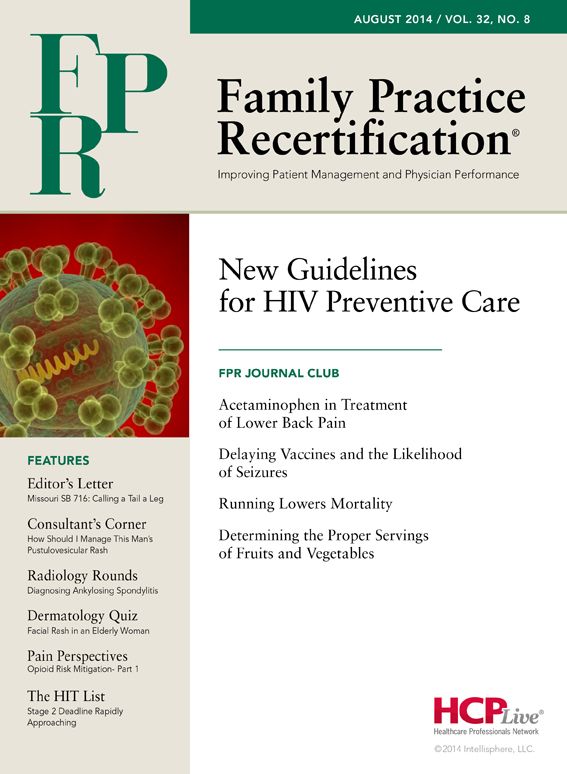Publication
Article
Family Practice Recertification
Running Lowers Mortality
Author(s):
Taking a closer look at the relationship between running and cardiovascular mortality

Frank J. Domino, MD
Review
Duck-Chul, L. et al. “Leisure Time Running Reduces All-Cause and Cardiovascular Mortality.” JACC 2014; 64(5):472-81).
While exercise has been long touted as a method to improve health outcomes, little is known about the direct effects of running on mortality. This prospective observational cohort study attempted to determine the influence on varying degrees of running as exercise on outcomes including myocardial infarction, stroke, or cancer, and all-cause mortality.
Study Methods
This prospective observational cohort study of a population of patients at the Cooper Clinic in Dallas, TX, was examined over time to determine the influence of running as exercise on outcomes. All were adults over age 18 (mean age 44 years) and included over 55,000 patients in the evaluation period. This group was evaluated for running method and time, and followed for all-cause mortality and cardiovascular mortality.
Participants were evaluated at baseline using a physical activity questionnaire, questioning duration, distance, frequency, and speed of activity. Participants were classified into 6 groups: non-runners, and 5 quintiles of weekly running based upon characteristics of time, distance, frequency and amount (calculated as metabolic equivalence MET), and speed for over 15 years.
Results and Outcomes
At the conclusion of the study there were 3,400 deaths due to all-cause mortality and 1,217 cardiovascular deaths. At baseline runners were more likely to be men, younger in age, and leaner. They were less likely to smoke, and participate in other types of physical activities, had lower prevalence of chronic disease, and had higher cardiovascular fitness levels.
Compared to non-runners, runners had a 30% lower relative risk of all-cause mortality and 45% lower relative risk of cardiovascular mortality after adjusting for confounders. This association held true of regardless of gender, age, BMI, health conditions, smoking status, and alcohol consumption.
Most encouraging was that runners across all 5 quintiles of weekly running time received an equivalent benefit. Even those in the lowest quintile of less than 51 minutes per week who demonstrated a lower risk of all-cause and cardiovascular mortality compared to non-runners.
Interestingly, the mortality benefits were similar between both lower and higher doses of weekly running. There were no significant differences in risk of all-cause mortality and cardiovascular mortality across the quintiles of weekly running, implying the same degree of benefit across the spectrum of running time, distance and speed.
Conclusion
Running for as little as 10 minutes per day, 5 days per week, and at speeds of less than 6 MPH results in a significantly lower risk of all-cause mortality and cardiovascular mortality.
Commentary
It has long been known that exercise improves outcomes, especially with regard to cardiovascular disease. This large prospective cohort study gives all adults encouragement that even a small amount of physical activity provides not only cardiovascular mortality benefit, but a reduction in all-cause mortality.
Its conclusions found as little as 10 minutes of exercise per day will provide a significant risk reduction. This does not need to be aggressive running, with speeds as low as 6 MPH having the same impact as more aggressive and much faster running. For perspective, the average adult walks approximately 4 MPH.
Significant data has come out in recent months demonstrating the efficacy of taking a brisk walk. From the American Journal of Clinical Nutrition (2013; 98:538), interrupting prolonged sitting with 100 seconds of walking every 30 minutes found a significant reduction in cardiovascular risk as well as diabetes serum markers. Another study published in 2013 looked at the effects of postprandial exercise on obese with pre-diabetes and found 15 minutes of exercise following meals was as effective and in many cases more effective than 1 large dose of exercise (Diabetes Care 2013; 36:3262).
Paramount among what we do as physicians is to help the patients live better and longer. This study is a call to all who provide health care. While many health interventions provide intermediate outcomes, very few provided improved mortality to this degree and with this little cost.
Family physicians should make it their priority to focus on change in activity level as well as improving fruit and vegetable intake (see prior article) as a means to help patients live longer and better. These two studies should be seen as a mandate, having greater improved outcomes compared to interventions like the use of aspirin for the primary prevention of heart disease and the use of statins for the primary prevention of cardiovascular disease.
About the Author
Frank J. Domino, MD, is Professor and Pre-Doctoral Education Director for the Department of Family Medicine and Community Health at the University of Massachusetts Medical School in Worcester, MA. Domino is Editor-in-Chief of the 5-Minute Clinical Consult series (Lippincott Williams & Wilkins).
Additionally, he is Co-Author and Editor of the Epocrates LAB database, and author and editor to the MedPearls smartphone app. He presents nationally for the American Academy of Family Medicine and serves as the Family Physician Representative to the Harvard Medical School’s Continuing Education Committee.






